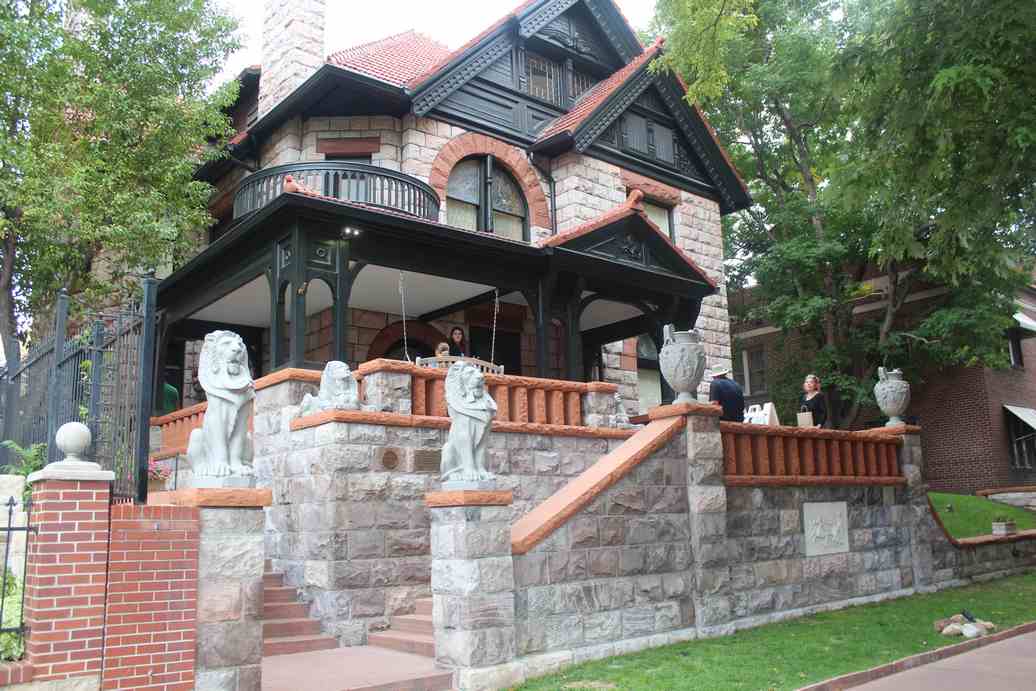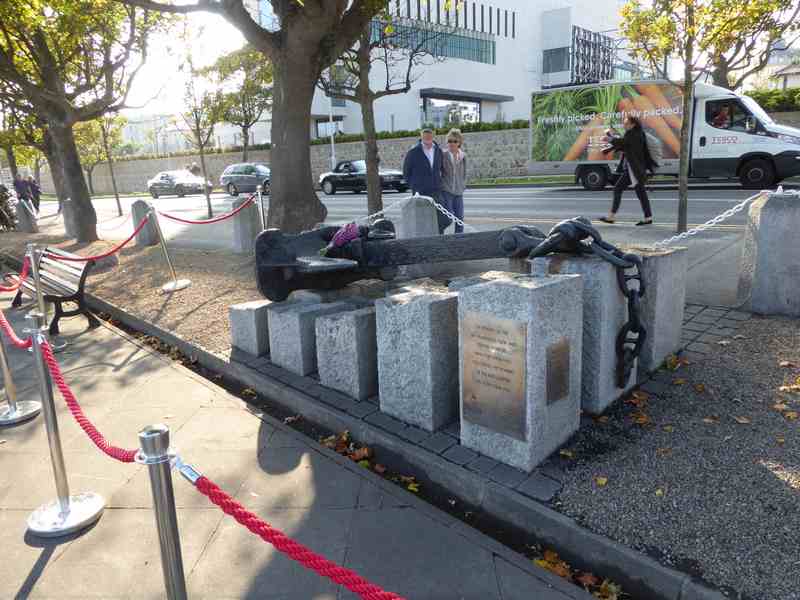Up the Line
The Unsinkable Molly Brown
Whilst Ann & I were in Denver, we visited the home of Margaret Brown. Born in Missouri in 1867 she moved to Leadville, Colorado and married James Brown a mining engineer. He became wealthy by creating more efficient equipment. They bought a house near the city centre. (In which we had a guided tour).
She became concerned over the conditions endured by the mineworkers and their families and helped in soup kitchens serving sustenance to them. She also joined the Denver Women’s Club and formed a cultural society, the Alliance Française.
She separated amicably from her husband in 1909 and having a settlement decided to tour Europe and beyond. In 1912, hearing that her eldest grandchild was ill; she booked a passage on the Titanic. However she survived and it is said that she pushed the crewman in the lifeboat to go back and look for survivors. When on the rescue ship Carpathia, she organised the other First Class women to prepare and serve soup to the poorer survivors.
During World War I she worked with the American Committee for Devastated France to help rebuild devastated areas behind the front line. She also helped wounded French and American soldiers. (The Chateau of Blerancourt, a French-American museum outside of Paris, has a commemorative plaque that bears her name). In 1932 she was awarded the French Legion of Honor for her "overall good citizenship," which included helping organize the Alliance Francais, her ongoing work in raising funds for Titanic victims and crew, her work with Judge Ben Lindsey on the Juvenile Court of Denver, and her relief efforts during World War I.
She died of a brain tumour in a New York Hotel in 1932. She was subsequently portrayed in a Broadway musical and film as ‘The Unsinkable Molly Brown’, however, she was never known as Molly in her lifetime.
Terry Jackson


100 years ago - the sinking of the RMS Leinster – a forgotten tragedy
Trevor Adams
The centenary of the sinking of the Leinster was on 10th October 2018. It was commemorated both in Dun Laoghaire (pronounced “Dun Leery”), from where it sailed, and in Holyhead, its destination. The maritime museums in both towns have been very busy in making preparations. I was at the event in Ireland, and Caroline was in Holyhead.
 (See the photos below at the end of the article- those present included families from as far away as New Zealand, the Welsh First Minister Caerwyn Jones, the Irish Minister for Culture Josepha Madegan, ambassadors and military attaches from all the countries involved, British, German, Australian, New Zealand, USA, and Canada, colour parties from all organisations involved, the head of the Irish Naval Service, and the head of the Irish Post Office).
(See the photos below at the end of the article- those present included families from as far away as New Zealand, the Welsh First Minister Caerwyn Jones, the Irish Minister for Culture Josepha Madegan, ambassadors and military attaches from all the countries involved, British, German, Australian, New Zealand, USA, and Canada, colour parties from all organisations involved, the head of the Irish Naval Service, and the head of the Irish Post Office).
The RMS Leinster was a ferry which not only carried Royal Mail letters and packets but on board the mail was actually sorted. (Of the 22 postal sorters at work on the day, only one survived.) Its sister ships, all Royal Mail Ships (“RMS”), were also named after the four ancient Irish provinces. The crews were drawn from both Ireland and Wales. The passengers comprised a mix of civilian and military. The military were both those living in Ireland and returning from leave, ones being transferred to GB, and visitors who were looking up relatives on their leave from active service, often emigres serving in the dominion armies. On the fateful journey, there were at least 771 passengers on board, but there is no definitive passenger list. The work by Philip Lecane in the Dun Laoghaire museum has created a list of 567 named casualties. For many years, the CWGC maintained that the casualty total was 176, but in fact that number comes from a 1919 HMSO publication and though it was not claimed to include any military casualties at the time, is frankly nonsense.
On the day in question, the Leinster left her berth in Dun Laoghaire, then called Kingstown, at 8.50am. Just after she had passed the Kish lighthouse some 7 miles out, she was hit by one torpedo at 9.50am. The ship was turned in an attempt to return to Dun Laoghaire but at about 9.55am she was hit by a second torpedo in the engine room and went down very quickly. The RMS Ulster had passed the Leinster a few minutes before the Leinster was hit, but the standing orders were that civilian ships were not to attempt to rescue survivors, as they would be a target for the submarine as well. The distress signal was passed by the Ulster to the Royal Navy, as the Leinster’s radio mast had been brought down. The destroyer HMS Liveley arrived after about an hour and a half, followed by the destroyers HMS Seal and HMS Mallard. The Helga, which had been used to suppress the Easter Rising in 1916, put to sea from Dublin and also took part in the rescue, as did tugs. Unfortunately, sea conditions on the day were poor being recorded by the RN ships’ logs as a wind speed of 6 to 7 from the south-west with a “very high sea” so that, although the lifeboats had been lowered, many had been swamped by the time help arrived. Photo right - no resting place but the sea - the Kish light, close to the site of the sinking
On their first landings at Dun Laoghaire, HMS Lively brought in 127 people, HMS Seal 51 survivors with two bodies, and HMS Mallard 20 survivors, with one body. Throughout the day of 10th October, boats continued to arrive at Dun Laoghaire with survivors and, inevitably, more bodies. By 10pm, more than 100 bodies had been recovered. Over the following weeks, bodies were washed up all over the Irish Sea coasts.
Many of the dead were buried in Grangegorman military cemetery in Dublin, which, incidentally, predates the formation of the CWGC. One North Walian there is Ezekiel Thomas of the RWF who was on his way home to Glan Conwy for his father’s funeral. A total of 12 RWF soldiers died on the Leinster, including one washed up at Abergele.
Civilian and military dead are buried far and wide.
- US sailor Perry Tailor is buried in Florida.(Don’t forget there was a considerable US Navy presence in Ireland by 1918*, and the Leinster had been escorted on occasions by US Navy ships, as well as by the Royal Navy.)
- Frank Higgerty, about to take up a commission in the army, is buried in Ottawa, Canada.
- Margaret Johnston is on the Great Orme at Llandudno.She was an English lady who had moved to Wales to avoid air raids in Southern England.
- Six crew are buried at Maeshyfryd in Holyhead, including a stewardess.
- On the Isle of Man, 11 identified bodies were washed up, some of which were repatriated, and a number of unidentifiable ones which were buried in unmarked graves on the island.Six known casualties are buried on the island today.
- A father and son, both called Charles Daft, are buried in Nottingham.
- The bodies of two members of the Royal Dublin Fusiliers, Lieutenant Crawford and Pte O’Brien, were washed up in SW Scotland and they are buried in Kirkbean and Portpatrick churchyards.
- Canadian nursing sister Henrietta Mellett is buried in Mount Jerome civilian cemetery in Dublin
In addition to the above,
- Twenty-six crew are on the Merchant Navy Memorial at Tower Hill in London, with addresses both around Holyhead and Dun Laoghaire.
- VAD Anne Barry is on the memorial at Brookwood cemetery in Surrey. There were 5 VADs killed on the Leinster.
- Josephine Carr was the first member of WRNS to be killed in action. She was a clerk from County Cork and is commemorated on the Royal Naval memorial in Plymouth.Her death gives added irony to the quirky motto for the WRNS “Never at sea”!
But what of Robert Ramm and his crew on UB-123? It is likely that the U-boat entered the Irish Sea by going round the north of Scotland, down the west coast of Ireland and up into the Irish Sea from the South. It is believed to have sunk the tanker Eupion 10 miles west of Ireland on 3rd October. After the Leinster sinking, UB-123 went north. On 18th October 1918, UB-125 outbound from Germany received a message from UB-123 asking for advice on a route through the Northern Barrage minefield which had been laid since March 1918 by the British and Americans to block the route for U-boats into the Atlantic from the North Sea. UB-125 responded with some suggestions. UB-123 acknowledged the message, presumably from a location north east of Muckle Flugga in the Orkney Islands. Nothing was ever heard of UB-123 again. She is presumed to have hit one of the mines that day, as both British and US ships reported hearing a mine explode. UB-123 was lost with all 36 crew.
Ironically, eleven days after the sinking of the Leinster, the German naval command issued an order to U-boats that they were only to attack military vessels and in daylight, as the armistice was pending.
So, why has the Leinster sinking been forgotten for so long?
- The Irish War of Independence broke out between Irish nationalists and the British forces within a year of the sinking.It thus suited each side to deliberately forget the part played in WWI by Irish men and women.Irish officialdom wished to construct a myth of perpetual Irish struggle against British imperialism down the centuries, and the Irish serving in the British forces was an awkward fact to deal with.British officialdom sought to downplay the Irish contribution to WWI, not least because of the loss of the Irish republic but also to justify the behaviour of British politicians and forces in Ireland in the 1919-1921 period.Thus, the loss of the Leinster became part of the suppression of WWI memories on all sides.
- Historians have made a mess of the issue and have grossly under-stated the deaths on the Leinster. As said above, this partly stems from a 1919 British publication that did not include military casualties British Vessels and Merchant Ships lost at sea 1914-1918 and, frankly, sloppy research work on the part of historians in subsequent years.
- A lack of information about those who died has also played a part.The tragedy itself has been remembered in Dun Laoghaire and Holyhead to some extent but it is really only with the stories of the victims becoming known that true remembrance is possible. Of course, the work of Philip Lecane and colleagues at the Irish Maritime Museum and those at the Holyhead Maritime Museum has been central to this task.
*By 1918, there were 34 US Navy destroyers based in Dun Laoghaire, and some 104 US Navy ships in SW Ireland, at Cobh and Bantry, including dreadnought battleships.
References
Torpedoed! The RMS Leinster Disaster, Philip Lecane, 2005, Periscope Publishing, Penzance, and talk to the Dublin WFA, June 2018
An underwater 3D image of the Leinster as she now lies is here
 Irish army piper playing the lament "Flowers of the Forest"
Irish army piper playing the lament "Flowers of the Forest"
 Welsh First Minister, Caerwyn Jones
Welsh First Minister, Caerwyn Jones
 The Australian military attache, Colonel Sue Graham
The Australian military attache, Colonel Sue Graham
 Irish Culture Minister, Josepha Madegan, unveils the new stamp
Irish Culture Minister, Josepha Madegan, unveils the new stamp
 The RMS Leinster memorial at Dun Laoghaire harbour - it is the anchor of the Leinster, retrieved in the 1990s
The RMS Leinster memorial at Dun Laoghaire harbour - it is the anchor of the Leinster, retrieved in the 1990s
